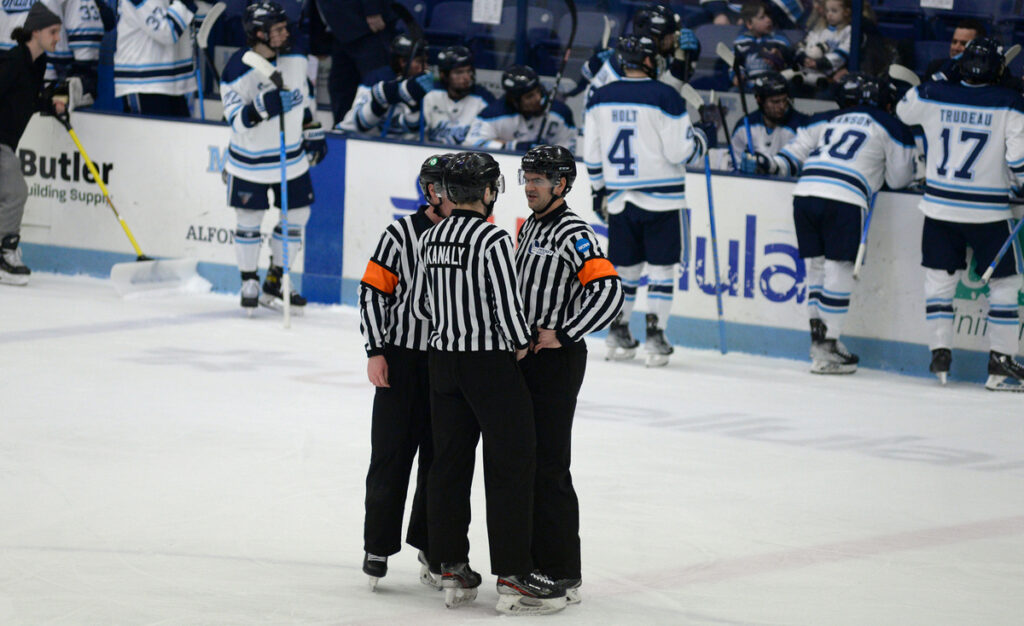Last season, if a U.S. college hockey player touched the puck with his stick more than four feet off the ice, a referee was required to blow the whistle to stop play and trigger a faceoff.
No more.
Last month, the NCAA Athletics Rules Oversight Committee voted to change the high stick rule.
Starting this season, both men and women will be allowed to play with pucks at shoulder height, but not above shoulder height.
This also applies if you score by lifting your stick high.
The high stick rule changes proposed by the NCAA men's and women's ice hockey committees to the Competition Rules Oversight Committee are designed to streamline calls for referees, according to an article on NCAA.org.
Previously, officials had to make a call on whether the puck was four feet off the ice.
University of Maine coach Ben Barr said he would wait and see because players' sizes could affect decisions.
“How high are the shoulders of a player who is 6ft 6in tall?” asked Barr. “A goal is 4ft high. If he scores with his stick above the crossbar, is it a goal or not?”
“I don't know if it's going to make it easier or harder for the umpires. It's hard to say,” Barr said.
This is one of several rule changes that will be implemented for the 2024-25 season.
Other rule changes include:
- If a team scores a goal due to a delayed penalty, the penalty against the opposing player is cancelled and both teams will have equal strength.
A few years ago, the NCAA implemented a rule that requires the penalized player to serve a two-minute penalty even if a goal is scored during a delay-of-game penalty situation.
This means that a team can score two goals with one penalty.
Barr said he was happy the rules were changed to what they were before.
“That could have had a dramatic effect on the game. It's (tough) to have a goal scored on and then have to erase the penalty,” Barr said. “(NCAA hockey) was the only major level that did that.”
- If the referee loses sight of the puck and blows the whistle, and the puck crosses the goal line immediately and in continuous motion, the referee may award a goal.
Last year, the game did not count even if the puck went into the net because the play ended the moment the whistle blew.
Barr supports the new rules.
“If (play continues) and the puck is in the net, it should count. It's a good rule,” Barr said.
- Based on video review, the referee may reduce a five-minute heavy penalty to a two-minute light penalty or no penalty at all.
Previously, a two-minute minor could be upgraded to a five-minute major upon review, but a five-minute major could not be downgraded.
“It shouldn't just work one way, it should work both ways,” Barr said. “It could be a critical moment in the game. If a mistake is made, the umpire should be able to correct it.”
However, the umpire can also add a match misconduct or disqualification to the five-minute penalty that removes the penalized player from the game.
In the case of a disqualification, the penalized player is suspended for the next game. The league may suspend a player penalized for a match tampering offense, although this is not necessarily the case for a match tampering offense.
A player who receives a five-minute major penalty for contact with the head will also be assessed a disqualification from the game or a game misconduct penalty, unless the official determines based on video review that a two-minute minor penalty or no penalty is due.
The umpire has all the options available to him when it comes to rear-end violations.
According to an article on NCAA.org, there will be more emphasis on the victim of a head contact or hit from behind infraction and whether the person could have avoided the contact.
“There's some responsibility on the player who gets hit to try to protect themselves,” Barr said.
For example, a clean check can turn into a five-minute major for a hit from behind if the player who received the hit turns their back on the checker at the last moment and the checker doesn't have time to get out of the hit.
Hockey East deputy commissioner Brian Smith said the rule changes on penalties for contact to the head and hits from behind were aimed at giving referees “more discretion and options.”
Other minor changes include the ability for teams to appeal disqualifications of matches to the Executive Director/Rules Editor and the National Umpires Coordinator.
In postseason games using video replay officials, review of winning goals in overtime is optional. If review is required, the on-ice official may consult with the video replay official, but the final decision is made by the official.
In women's hockey, the committee approved additional language to identify unintentional collisions, including those caused by contact resulting from the pursuit of the puck.
Smith said the rule allows for more “physical north-south play on the ice” by allowing players to use body position and angles to their advantage in battles for the puck.
Body checking is prohibited in women's college hockey, but incidental contact involving a fight for the puck is permitted.
The potential increase in physicality in the women's college game will be beneficial for players aspiring to play at the professional level, as more physical contact will be allowed in the first year of the professional women's hockey league.
“We want our (Hockey East) players to be ready to play at the next level,” Smith said.

